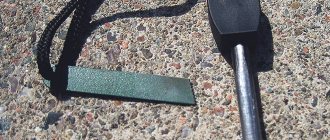In the process of catching predatory fish, it is necessary to use different methods of recording the catch. Some people turn to the help of a hook or a landing net, while other fishermen do everything exclusively with their hands. Nowadays, the use of a special device for catching fish - a lipgrip - is gradually gaining popularity.
Lipgrip is a jaw grip for holding fish, which works on the principle of strong compression. They are convenient for taking fish out of the water, as well as holding it to remove hooks.
Lip grips come in metal and plastic, and differ in shape and grip strength.
What is a lip grip and how to use it when fishing
In the process of catching predatory fish, it is necessary to use different methods of recording the catch. Some people turn to the help of a hook or a landing net, while other fishermen do everything exclusively with their hands. Nowadays, the use of a special device for catching fish - a lipgrip - is gradually gaining popularity.
Lipgrip is a jaw grip for holding fish, which works on the principle of strong compression. They are convenient for taking fish out of the water, as well as holding it to remove hooks.
Lip grips come in metal and plastic, and differ in shape and grip strength.
Operating principle of the extractor
How to use the extractor?
A fishing extractor is designed to quickly remove a hook from a fish's mouth. There are two types of extractors: one type is made in the form of a needle, at the end of which there is a special cut, with the help of which the extraction process is carried out, and the second type is made in the form of tweezers, with the help of which the hook is grabbed and pulled out. To ensure a reliable grip, notches are made on the tips of the tweezers, which allow you to securely grip the hook.
Portability of the lipgrip
This tool has quite compact dimensions and low weight. This allows you to use it in almost any conditions, be it coastal fishing or fishing from a boat. Of course, it may not be needed for small fish, but when, for example, a medium pike is hanging on the hook, the lipgrip becomes very useful.
The device can be attached using a clip to any equipment or placed in a bag; it will not take up much space. When the need to use it arises, the lipgrip is automatically taken in one hand and then the predator is easily grabbed by the jaw.
A high-quality lipgrip reliably holds fish of almost any size, without actually causing injury to it. True, for pikes weighing more than 6 kg it is better not to use it, since the soft tissues of the pike can tear and the pike will fall. Once the capture is completed, you can safely release the catch from the hook and not worry about its possible loss.
As a rule, a special cord is included with the lipgrip, which is needed to prevent the instrument from falling into the water. As for the price issue, the cost of such a device is approximately the same as the cost of an inexpensive landing net.
Control
The control is tricky - three triggers. You won’t be able to figure out what order to press them in right away. The Free and Lock buttons are a single element; pressing on one side pushes out the trigger on the other side. Those. either Free or Lock. There is logic in this.
The algorithm of actions is as follows:
— Press the Free button with the base of your thumb. - Using the same finger, we press the main spring-loaded Push button - we open the jaws. — We hook the fish’s mouth, release the main button - the lips close. — Press and, just in case, hold the Lock button with your index finger — the fish is locked.
It seems to be nothing complicated. But here's what happened when I used the lipgrip for the first time: My wife caught a 1+ kg pike, I hasten to the rescue - show off my prowess with a new lipgrip and get the fish out of the water... What you notice right away is that the fish does not want to swim up on its own with its mouth open :) Where Should I insert a “claw”? Question. Somehow I hooked the lower jaw of the pike, released the main button - the lips of the lipgrip closed. Everything is in order, I think. I lift the fish out of the water and the pike makes a powerful somersault and frees itself from its grip! He falls into the water and leaves. My wife’s gratitude for my help knew no bounds, this pike will be calling me back for a long time :) But the fact is that I didn’t press the Lock button as I should have - out of habit, I didn’t even remember about it... I tried to continue to take the fish out of the water with a grab and constantly came across a problem - it is extremely difficult to force the fish to open its mouth, swim within the reach of the lipgrip and grab it by the jaw with the rather narrow claw of the device. As a result, I abandoned this idea.
I found another use for the grip, which it copes with with a bang: After catching a fish, I grab it by the jaw already on the shore or in a landing net and lift it. Hook access is excellent. With one hand I hold the grip with the pike, with the other I use pliers to free the fish from the hooks. Usually this procedure turns into a tedious and slimy operation. With the use of lipgrip it became a pleasure. And my hands are clean, and the pike won’t hurt me with the hooks when jerking, and it holds securely. After freeing from the hooks, you can also conveniently either place the fish on a kukan or in a cage, or release it without damaging the mucus cover. I am very pleased with this functionality.
More “captured” pikes
It’s convenient to take a photo of the trophy with a lipgrip)
Performing its main function of capturing and fixing fish, the lipgrip remains a very convenient device. It will definitely appeal to those fishermen who like to quickly photograph their trophy, because with it such a procedure is much simpler, and the pictures turn out more successful.
The only relative disadvantage of the lipgrip is that if it is not handled very skillfully and carefully, it can still cause significant injuries to the fish, but in this case everything depends on the fisherman himself and, partly, the behavior of the fish.
But be that as it may, at least you can be sure that the catch will not go anywhere. And small tears in living tissue in the jaw are no more scary than similar punctures from a tee.
The life of a fisherman
Probably every fisherman has seen lip grips, but not everyone uses them in fishing.
I came across them quite a long time ago on the Internet, but I always treated them with a certain contempt and always believed that a fish could swing its head with a three-hook bait and plant the hooks in the hand, which would try to shove the lipgrip into its mouth))) So I never considered lipgrip as part of his arsenal. One of my friends started using lip grips, if I’m not mistaken, he has 2 of them. Then they sent it to someone else as a gift for shopping. They used them to free already caught fish from hooks. I also took pictures with my last year’s trophies in my friend’s boat with his little lip grips. It’s comfortable to hold the fish, I liked it and decided to buy myself a lip grip.
I chose the lip grip relatively quickly, because... it was big and constantly flashed before my eyes, but its price tag was stinging for me. The lowest price I saw on sale was 450 rubles, but I made more priority purchases, a spinning rod for a twitch, a reel, or something else. And so I still ordered it for myself on June 19th. The order was received on July 8. Delivery speed is very good.
So lipgrip from Castking
Judging by the inscriptions on the box it says large size, floating lip grip. I don’t know English, and I don’t want to get involved in a translator, but the best one seems like this))
There is a barcode on the back.
When you open the box, there is a sticky grip and a piece of paper with a loyalty program.
I don’t know what it is, but it’s written and designed beautifully))) I decided, just for fun, to go to the site and write down an application for membership, which, by the way, will be considered for a week))) They promise discounts and other nonsense, but I don’t think this will affect me, because my purchases from casting are so frequent and expensive. As far as I remember, I bought 3 centron reels and this lip grip. Over time, I’ll probably transfer all my spinning rods to these reels, but it will take years)))
The lip grip comes with a long cord. I don’t know if this is important or not, but here it is. The lace has casting inscriptions and is very pleasant to the touch.
The total length of the jaw grip is just over 25 cm. In the third photo below, the barcode says 10 inches, when converted to cm it turns out to be 25.4 cm.
Even though the photos I took this time are so weird that you can’t see anything in them))
Grip length. I don’t know whether anyone needs it or not, but I was personally interested in the length of the closing part of the grip, it is more than 2 cm. This is the part of the grip that will be in the fish’s mouth, it is relatively large and not sharp. Those. Unlike metal linden grips, this grip should not easily tear the film of the fish’s lower jaw.
The length of the handles is about 13 cm.
A fully extended grip looks like this.
I have small hands, but with one hand I can basically do everything.
In general, it’s difficult for me to evaluate it somehow, because... all the years as I wrote above, I treated them with a certain contempt. The device is made with high quality. It floats, I checked it in a barrel and threw it at everything to check. The gripping surface area is large, which I liked. I'll catch it and see how it goes. Anyone who often visits my blog will, I think, see it in photos and videos, then I’ll add a post if anything happens to it or if it makes some big impression on me.
Source
Review of lipgrip from aliexpress
If you adhere to the “catch and release” principle, then it is better not to lift a large pike vertically with a lipgrip, as this can damage its spine.
The most humane way for the pike is to grab it with a lip grip, and then in the water, unhook the tee with pliers, without lifting the pike to the shore or side of the boat.
At the end of the article, we note our partner - the Savelyevo fishing club, which is engaged in fish farming and fishing in private reservoirs. So, if you are located near the Moscow region and want to have good fishing, we recommend their paid fishing ponds.
All the best to you, take care of nature and release the caught fish). No bragging, no fluff.
Disassembly
The device is assembled using hexagon screws, which is already very good because can be disassembled or tightened. There are 6 screws, unscrewed with a 2 hexagon. At first I thought they were rivets and only after looking closely did I see “hexes”. When disassembling, the springs scatter around the room, you have to be careful. Bearing bushings are installed in all moving joints:
The body linings are made of thick aluminum sheet and feel very durable:
The large spring ensures that the main fish lock operates using the Push button, while the small spring provides a clear click on the “Lock-Free” buttons, eliminating intermediate positions of the triggers.
Inside, everything is made well and conscientiously; I did not find any flaws or plastic parts - everything is made of metal.
How it works and how it happens
Essentially, a lipgrip is something similar to pliers, wire cutters, and similar tools. Only at the moment when we press the handles all the way does it stop. Like pliers that have been lying on the street for a long time and are slightly rusty - we close them all the way and they stop due to rust.
According to the design and material of manufacture, grips (lip grips) are of two types:
- Metal, with thin ends. This one usually has a round handle and sinks in water. It has one more significant drawback: it pierces the fish’s jaw, leaving two small holes in it. This does not lead to death in fish, but still.
- The second type is a plastic lipgrip. It does not sink, and its clamp ends are flat, with small heels. It leaves no marks on the fish's jaw. A significant point that prevents even greater demand for it is the prevailing stereotype that plastic is fragile and fragile. But that’s exactly what he’s doing well with. After all, some plastic is stronger than modern metal. Therefore, all the arguments in favor of a plastic jaw grip are:
- He doesn't drown;
- Does not leave injuries on the predator’s body;
- It is lighter and more compact.
But, like any thing, lip grip has its disadvantages:
- First. In order to catch a predatory fish, you need appropriate skill, experience and training. And, importantly, this takes time.
- Second, if you come across a large fish, then you need to be careful. When you take the fish by the jaw and close the handles, the fish begins to thrash, sometimes very violently. At this moment, the pike can not only break its jaw, but also twist your arm. What to do? The solution to this problem is simple. When you hold the fish, try to leave your hand free to move. This way you can avoid injury not only to yourself, but also to the fish.
Let's summarize. In modern fishing you cannot do without a lipgrip. It will help us not only avoid injury, but also keep the trophy alive so that we can take a few photos and release it into its native element.
What's the result?
We have a convenient device for holding fish after catching for release from hooks and carrying. As a replacement for a landing net, it’s not suitable for me. Or I'm not smart enough.
Pros:
— High quality workmanship of all elements; — Not a single plastic part; — Strong coating; — Beautiful appearance; — Flat form factor (fits perfectly in your pocket); — Minimizes injury to fish and anglers when removing hooks; — Over several fishing trips, no additional backlashes appeared; — Getting rid of fish mucus on your hands. - Collapsible.
Minuses:
— Small opening angle of the jaws; — Too many buttons — complicated grip control; - Expensive.
I don’t consider it necessary to attribute the fact that it is difficult to catch fish in the water with a lipgrip to the disadvantages of this particular device - I think this is a feature of all such devices. In the store that sent me this grip, they are now in the “Out of Stock” status, but I couldn’t find them on Ali. But I think the principle of operation of lip grips is similar and you can choose the one you like. I hope my review will help you decide whether to purchase such a device. I will also be glad to hear your tips on use, maybe I missed some subtlety.
The product was provided for writing a review by the store. The review was published in accordance with clause 18 of the Site Rules.
mysku.ru
Lipgrip: aesthetics or barbarism?
Among modern spinning anglers, the catch-and-release (CR) fishing principle is quite common. Which, in general, is logical. Spending thousands of dollars on gear and equipment (I’m already silent about equipping boats and fish-finding electronics), and at the same time bringing home our river fish for food seems somewhat ridiculous. About 10-15 years ago, only a few followed software principles. Now, even in the outback, many fishermen release at least some of the fish back into the reservoir without remorse. And as expected, new issues of humane treatment of the fish, which will be released into their native elements, surfaced on the agenda. The injured gills, pierced eyes and swollen swim bladders seem to have been sorted out a little. Become more careful. We learned how to do fizzing. We have slowly “grown up” to silicone landing nets and reducing the contact of bare hands with the body of the fish in trout fishing. It’s time to meticulously consider such a fishing tool as a lipgrip - a jaw grip for holding fish.
Jaw fishing grip. (Views: 1)
Jack.
Does anyone use these or something similar?
are they any use?
———- Message added at 19:58 ———- Previous message posted at 19:49 ———-
for example like this
Attachments
Dimulya
Re: fishing jaw grip
A friend of mine uses a similar one. Looking from the side, I’ll grab a fish faster with my hands or a landing net than with a catch, it’s not a fact that you’ll catch it the first or second time! I always smiled looking at my friend at this time. Skhodov also saw a lot in the process of hooking
Re: fishing jaw grip
A very competent and successful model of this grip from Pontoon21, I liked it more for the convenience and reliability of ordinary traditional models. In addition, it is very light, you hung it on your belt and forgot that you had it. Not an advertisement, don’t think about it.
Attachments
Jack.
Re: fishing jaw grip
Uzun555
Re: fishing jaw grip
There is something like this, say a beautiful toy for advertising! It is very difficult to force a predator, and especially a pike, to open its mouth, and you yourself understand that at this moment it can jerk and get away! I take it with me as a pair to the landing net, because... With a landing net I take the fish that is of a decent size! I use the “Lip Grip” when I don’t want to get my hands dirty and getting off is not important, it also holds securely, that is, it’s safe to pull the bait from the predator!
Jack.
Re: fishing jaw grip
I think this one is much cooler.
Dimulya
Re: fishing jaw grip
What's cool about it? I've seen enough of these grabs, even after the 10th attempt they couldn't grab them! From the boat I don’t understand what’s the point of this crap when there’s a landing net once or twice and in the boat! With capture there is an order of magnitude more work
Re: fishing jaw grip
I think this one is much cooler.
Jack.
Re: fishing jaw grip
Uzun555
Re: fishing jaw grip
Re: fishing jaw grip
Does anyone use these or something similar?
are they any use?
By the way, the pike in the second photo was caught “by the skin” (the fish missed the jig and barely caught on the outside of the jaw) and swam to the shore with its mouth closed (there’s nothing to spit out, the bait is outside).
Attachments
Jack.
Re: fishing jaw grip
What do you think about the one in the link? Take a closer look and give your opinion
Uzun555
Re: fishing jaw grip
I have this Lip Grip from Berkeley, the grip is very reliable; it holds a piece of paper in its grip; when you pull, it doesn’t pull out, but breaks!
Types of extractor for fishing
Extractor in the form of a needle
As mentioned above, there are two types of extractors. Most fishermen use a needle-shaped tool, since its operating principle is somewhat simpler, and it takes up less space. Plus, they are much more reliable. If you handle it correctly and carefully, it can last for more than one season. Needle extractors are made from both metal and plastic.
Needle-type extractor models are very popular among fishermen because they are reliable, lightweight and compact. In addition, with their help it is easy to pull the hook out of the mouth of even a very small fish, such as a perch, for example. Very often, anglers hang it around their neck with an elastic band, which allows them to act much faster. In this position, it does not interfere with the fisherman at all, since it is quite light.
Extractor in the form of tweezers
The second option is an extractor in the form of tweezers. A similar device is made of metal, so this type is also reliable. At the same time, its handles are rubberized, so they are quite comfortable, allowing you to work even with wet hands.
This extractor is used mainly by spinning anglers who practice catching predatory fish, especially pike. With the help of such an extractor, it is convenient to pull out various artificial baits armed with several sharp tees from the mouth of a predator. They also take up little space, although slightly larger than needle-shaped extractors. Unfortunately, with such an extractor it is difficult to remove the hook from the mouth of, for example, an average crucian carp. But to get a hook out of the mouth of a pike or pike perch, you simply cannot do without tweezers.











